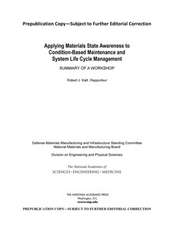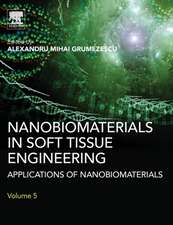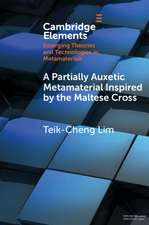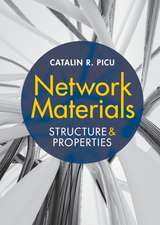Thermoelectric Skutterudites
Autor Ctirad Uheren Limba Engleză Paperback – 31 mai 2023
This exciting material is of growing importance and is finding applications in a variety of different fields. This book will be of interest to researchers working in materials science, physics, and chemistry in addition to graduate students in these subjects.
Features:
• Gives a comprehensive account of all fundamental physical properties of skutterudites
• Each major topic is accompanied by introductory sections and a further detailed theoretical treatment is provided in Appendices
• Supported by many figures and a vast number of relevant references
| Toate formatele și edițiile | Preț | Express |
|---|---|---|
| Paperback (1) | 355.99 lei 6-8 săpt. | |
| CRC Press – 31 mai 2023 | 355.99 lei 6-8 săpt. | |
| Hardback (1) | 1284.86 lei 6-8 săpt. | |
| CRC Press – 19 mai 2021 | 1284.86 lei 6-8 săpt. |
Preț: 355.99 lei
Preț vechi: 404.25 lei
-12% Nou
Puncte Express: 534
Preț estimativ în valută:
68.14€ • 74.04$ • 57.27£
68.14€ • 74.04$ • 57.27£
Carte tipărită la comandă
Livrare economică 21 aprilie-05 mai
Preluare comenzi: 021 569.72.76
Specificații
ISBN-13: 9780367615376
ISBN-10: 0367615371
Pagini: 338
Ilustrații: 20 Tables, black and white; 119 Line drawings, color; 57 Line drawings, black and white; 9 Halftones, color; 6 Halftones, black and white; 128 Illustrations, color; 63 Illustrations, black and white
Dimensiuni: 178 x 254 mm
Greutate: 0.68 kg
Ediția:1
Editura: CRC Press
Colecția CRC Press
ISBN-10: 0367615371
Pagini: 338
Ilustrații: 20 Tables, black and white; 119 Line drawings, color; 57 Line drawings, black and white; 9 Halftones, color; 6 Halftones, black and white; 128 Illustrations, color; 63 Illustrations, black and white
Dimensiuni: 178 x 254 mm
Greutate: 0.68 kg
Ediția:1
Editura: CRC Press
Colecția CRC Press
Public țintă
Academic, Postgraduate, Professional, and Professional Practice & DevelopmentCuprins
Contents
Preface.......................................................................................................................................xi
About the Author.......................................................................................................................xv
Chapter 1 Structural Aspects of Skutterudites............................................................................1
Chapter 2 Fabrication of Skutterudites......................................................................................65
Chapter 3 Electronic Energy Band Structure.............................................................................. 91
Chapter 4 Electronic Transport Properties of Skutterudites..................................................... 129
Chapter 5 Thermal Transport Properties of Skutterudites........................................................ 169
Chapter 6 Thermoelectric Properties of Skutterudites.............................................................. 261
Index........................................................................................................................................... 319
Preface.......................................................................................................................................xi
About the Author.......................................................................................................................xv
Chapter 1 Structural Aspects of Skutterudites............................................................................1
Chapter 2 Fabrication of Skutterudites......................................................................................65
Chapter 3 Electronic Energy Band Structure.............................................................................. 91
Chapter 4 Electronic Transport Properties of Skutterudites..................................................... 129
Chapter 5 Thermal Transport Properties of Skutterudites........................................................ 169
Chapter 6 Thermoelectric Properties of Skutterudites.............................................................. 261
Index........................................................................................................................................... 319
Notă biografică
Ctirad Uher is a C. Wilbur Peters Professor of Physics at the University of Michigan in Ann Arbor.
He earned his BSc in physics with the University Medal from the University of New South Wales
in Sydney, Australia. He carried out his graduate studies at the same institution under Professor H.
J. Goldsmid on the topic of ‘Thermomagnetic effects in bismuth and its dilute alloys’, and received
his PhD in 1975. Subsequently, Professor Uher was awarded the prestigious Queen Elizabeth
II Research Fellowship, which he spent at Commonwealth Scientific and Industrial Research
Organization (CSIRO), National Measurement Laboratory (NML), in Sydney. He then accepted a
postdoctoral position at Michigan State University, where he worked with Profs. W. P. Pratt, P. A.
Schroeder, and J. Bass on transport properties at ultra-low temperatures.
Professor Uher started his academic career in 1980 as an assistant professor of Physics at the
University of Michigan. He progressed through the ranks and became full professor in 1989. That
same year the University of New South Wales awarded him the title of DSc for his work on transport
properties of semimetals. At the University of Michigan, he served as an associate chair of
the Department of Physics and subsequently as an associate dean for research at the College of
Literature, Sciences and Arts. In 1994, he was appointed as chair of physics, the post he held for the
next 10 years.
Professor Uher has had more than 45 years of research, described in more than 520 refereed
publications in the areas of transport properties of solids, superconductivity, diluted magnetic semiconductors,
and thermoelectricity. In the field of thermoelectricity, to which he returned during
the past 25 years, he worked on the development of skutterudites, half-Heusler alloys, modified
lead telluride materials, magnesium silicide solid solutions, tetrahedrites, and Molecular Beam
Epitaxy (MBE)–rown thin films forms of Bi2Te3-based materials. He has written a number of
authoritative review articles and has presented his research at numerous national and international
conferences as invited and plenary talks. In 1996, he was elected fellow of the American Physical
Society. Professor Uher was honored with the title of Doctor Honoris Causa from the University of
Pardubice in the Czech Republic in 2002, and in 2010 was awarded a named professorship at the
University of Michigan. He received the prestigious China Friendship Award in 2011.
Professor Uher supervised 16 PhD thesis projects and mentored numerous postdoctoral researchers,
many of whom are leading scientists in academia and research institutions all over the world.
Professor Uher served on the Board of Directors of the International Thermoelectric Society. In
2004–2005, he was elected vice president of the International Thermoelectric Society and during
2006–2008 served as its president.
He earned his BSc in physics with the University Medal from the University of New South Wales
in Sydney, Australia. He carried out his graduate studies at the same institution under Professor H.
J. Goldsmid on the topic of ‘Thermomagnetic effects in bismuth and its dilute alloys’, and received
his PhD in 1975. Subsequently, Professor Uher was awarded the prestigious Queen Elizabeth
II Research Fellowship, which he spent at Commonwealth Scientific and Industrial Research
Organization (CSIRO), National Measurement Laboratory (NML), in Sydney. He then accepted a
postdoctoral position at Michigan State University, where he worked with Profs. W. P. Pratt, P. A.
Schroeder, and J. Bass on transport properties at ultra-low temperatures.
Professor Uher started his academic career in 1980 as an assistant professor of Physics at the
University of Michigan. He progressed through the ranks and became full professor in 1989. That
same year the University of New South Wales awarded him the title of DSc for his work on transport
properties of semimetals. At the University of Michigan, he served as an associate chair of
the Department of Physics and subsequently as an associate dean for research at the College of
Literature, Sciences and Arts. In 1994, he was appointed as chair of physics, the post he held for the
next 10 years.
Professor Uher has had more than 45 years of research, described in more than 520 refereed
publications in the areas of transport properties of solids, superconductivity, diluted magnetic semiconductors,
and thermoelectricity. In the field of thermoelectricity, to which he returned during
the past 25 years, he worked on the development of skutterudites, half-Heusler alloys, modified
lead telluride materials, magnesium silicide solid solutions, tetrahedrites, and Molecular Beam
Epitaxy (MBE)–rown thin films forms of Bi2Te3-based materials. He has written a number of
authoritative review articles and has presented his research at numerous national and international
conferences as invited and plenary talks. In 1996, he was elected fellow of the American Physical
Society. Professor Uher was honored with the title of Doctor Honoris Causa from the University of
Pardubice in the Czech Republic in 2002, and in 2010 was awarded a named professorship at the
University of Michigan. He received the prestigious China Friendship Award in 2011.
Professor Uher supervised 16 PhD thesis projects and mentored numerous postdoctoral researchers,
many of whom are leading scientists in academia and research institutions all over the world.
Professor Uher served on the Board of Directors of the International Thermoelectric Society. In
2004–2005, he was elected vice president of the International Thermoelectric Society and during
2006–2008 served as its president.
Recenzii
"In this superbly modern monograph, Uher (Univ. of Michigan) brings extensive research on the materials science of thermoelectricity to bear on specific skutterudite thermoelectrics, most commonly alloys of arsenic or antimony with transition metals (cobalt or nickel). The materials science goal is to maintain high electrical conductivity with low thermal conductivity, thus developing the engineered capability of converting heat to electric current (Seebeck effect) or electric current to heat (Peltier effect) in joined, dissimilar materials, or the Thomson effect in a uniform conductor. Engineering applications, hinging on material availability and the low cost of skutterudites, include converting discarded heat to electricity, or using electricity to achieve refrigeration.
Uher strikes an excellent balance between solid-state physics, materials science, and engineering, in chapters on skutterudite crystal structure, fabrication (including thin film forms), electronic band structure, electronic transport properties, thermal transport, and skutterudite thermoelectric properties. The discussion of figures of merit in the final chapter is insightful, as are those on means of reducing thermal conductivity and on pressure effects. Each chapter includes an up-to-date bibliography. Several aspects of thermoelectric research, e.g., comparing other materials with skutterudites, economic aspects of thermoelectricity, or applications of machine learning in identifying promising alloys, are only mentioned. Readers need background on solid-state physics, crystal structures, and phase diagrams. Summing Up: Highly recommended. Graduate students, faculty, and professionals."
—J. Lambropoulos, University of Rochester in CHOICE, April 2022
Uher strikes an excellent balance between solid-state physics, materials science, and engineering, in chapters on skutterudite crystal structure, fabrication (including thin film forms), electronic band structure, electronic transport properties, thermal transport, and skutterudite thermoelectric properties. The discussion of figures of merit in the final chapter is insightful, as are those on means of reducing thermal conductivity and on pressure effects. Each chapter includes an up-to-date bibliography. Several aspects of thermoelectric research, e.g., comparing other materials with skutterudites, economic aspects of thermoelectricity, or applications of machine learning in identifying promising alloys, are only mentioned. Readers need background on solid-state physics, crystal structures, and phase diagrams. Summing Up: Highly recommended. Graduate students, faculty, and professionals."
—J. Lambropoulos, University of Rochester in CHOICE, April 2022
Descriere
This book informs the reader about a fascinating class of materials referred to as skutterudites, the atomic lattice of which has large structural voids that can be filled by a variety of foreign species, spanning from alkali to alkaline to rare earth ions.





















